My pictures include this our first stop at the abbey church of Klosterneuburg Monastery.
We then visited the Heiligenkreuz Abbey, near Mayerling Hunting lodge. The Mayerling Hunting Lodge was the site of what is referred to as The Mayerling Incident, the series of events leading to the apparent murder-suicide of Rudolf, Crown Prince of Austria and his lover, Mary Vetsera. Rudolf was the only son of Emperor Franz Joseph I of Austria and Empress Elisabeth (second to the eldest daughter of Queen Victoria of Great Britain), and heir to the throne of the Austro-Hungarian Empire. Rudolf's mistress, Vetsera a baroness, was the daughter of a diplomat at the Austrian court. The bodies of the 30-year-old crown prince and the 17-year-old baroness were discovered in the Imperial hunting lodge at Mayerling on the morning of January 30, 1889. Still being investigated in 2015, the Austrian National Library issued copies of Vetsera's letters of farewell to her mother and other family members. These letters, previously believed lost or destroyed, were found in a safe deposit box in an Austrian bank, where they had been deposited in 1926. The letters, written in Mayerling shortly before the deaths, state clearly and unambiguously that Vetsera was preparing to commit suicide alongside Rudolf, out of "love".
Franz Joseph did everything in his power to get the Church's blessing for Rudolf to be buried in the Kapuzinergruft Imperial Crypt, which would have been impossible had the crown prince deliberately committed murder and suicide. A special dispensation was obtained from the Vatican that declared Rudolf to have been in a state of "mental imbalance", and he now lies with 137 other Habsburgs in the Church of the Capuchins in Vienna.
The death of the crown prince had momentous consequences for the course of history in the nineteenth century. It had a devastating effect on the already compromised marriage of the Imperial couple and interrupted the security inherent in the immediate line of Hapsburg dynastic succession. As Rudolf had no son, the succession would pass to Franz Joseph's brother, Karl Ludwig and his issue, Archduke Franz Ferdinand. This destabilization endangered the growing reconciliation between the Austrian and the Hungarian factions of the empire, which became a catalyst of the developments that led to the assassination of the Archduke and his wife Sophie in June 1914 and the subsequent drift into the First World War.
Below are pictures of the Heiligenkreuz Abbey
Mary Vetsera is buried near this abbey.
On our return tour to Vienna, as promised, we were dropped at the Vienna Opera House. From there, we made our way, walking back to the Hotel Domizil and, after a somewhat early supper, some of us were soon trying to get that sleep we had missed the previous night. Walking records for day 6.33 miles.
SUNDAY, OCTOBER 16, 2016 -The main event of today was the very reason we traveled on the train to Vienna, 8 days prior to our scheduled visit there while traveling on the riverboat. That event was the 11 a.m. performance at the Spanish Riding School. (Pictures show outside of buildings at Spanish Riding School).
And, a horse and rider!
(the above picture was taken from the front of the program)
The Spanish Riding School (German: Spanische Hofreitschule) is a traditional riding school for Lipizzan horses, which perform in the Winter Riding School located in central Vienna. Not only is it a center for classical dressage, but the headquarters is also a tourist attraction in Vienna that offers public performances as well as permitting public viewing of some training sessions. The presentation builds on four centuries of experience and tradition in classical dressage. The leading horses and riders of the school also periodically tour and perform worldwide. Performances take place in the Winter Riding School, built between 1729–1735. The Winter Riding School is a sunlight-flooded hall, mainly white with some beige and light grey, with a portrait of Emperor Charles VI above the royal box and opposite the entrance (to which the riders always salute before they ride), which measures 180 ft by 59 ft and is 17.56 ft in height. Since pictures are not allowed to be taken during the performance, I took the following "snaps" of the arena prior to the beginning of the show and before the beautiful chandeliers were raised so they would "clear" the riders.
In October of 2015, Sylvia began the search for tickets for this show only to learn that the tickets would go "on sale" in early Jan. 2016. So, she studied the layout of the room/arena and decided where the very best seats were located. And, so it was early in Jan. 2016 that she purchased (on-line) the very best seats available, one section for 4 between the two balcony supports shown above. (The company also sells tickets for "standing" behind those 4 seats, but except for those standing behind us, there was nothing to distract our view). The 90-minute performance included the opening with the "Young Stallions" followed by "All the Steps and Movements of the Classical School". Number 3 was "Work In Hand and Schools Above the Ground". Next was "On the Long Rein", and finally "School Quadrille" with 8 mature, magnificent stallions. (Interesting side note: in this group was one stallion--probably one of the younger of the group--whose coat was not yet white, but rather a dark grey much like our own Roi El Natall, the Arabian stallion with which we won multiple Nevada state championships in 1976.)
The show ended and we made our way back to our Hotel Domizil where we had lunch in a nice restaurant nearby. Our next event was a 2:00 p.m. pick up for a Viator Vienna Historical Tour & Schonbrunn Palace. The historical tour consisted of driving past important places with the guide mentioning their names. (I did not include any of the pictures taken during the drive because I find that pictures that were taken through the windows of a bus are never very satisfactory). We arrived at Schonbrunn Palace which we toured for about 2 hours. In many ways, Schonbrunn Palace seemed similar to other palaces we have visited, Versailles and those of St. Petersburg.
And, Sylvia & I in the same location
Once again our tour ended at the Opera House and we then walked to another stop, planned for the day, the Hotel Sacher, to eat one of the fabulous Sacher Tortes as described by our friend, Sarah Goebel.
It was as tasty as it looks!
Our return walk to the Hotel Domizil included a stop at the street vendor where we purchased wonderful foot-long hot dogs. (added to the torte, that was dinner!)
A word about our hotel, the "Hotel Domizil": it was one of that classic, old boutique hotels--found in cities of Europe--where the room key was brass and about 10 inches long, weighing a half a pound or more making it impossible to carry in a pocket. The procedure was to turn in the key at the front desk each time prior to departing, and collect it when returning. Walking records 6.26 miles
MON. OCT. 17, 2016 - (CRUISE DAY #1) At shortly after 9 a.m. we boarded a train for the 4 hour ride to Prague, Czech Republic, arriving about 1 p.m. A taxi took us from the train station to the Hilton Prague Old Town Hotel where we placed our luggage in storage awaiting the 3 p.m. check-in time. This was considered Day One of our 11-day Avalon Legendary Danube River Cruise even though we did not board the ship until Day Four. For those traveling directly to the city of departure, most of day one is usually taken up with flights from other locations. With a recommendation from the hotel staff we were able to locate a good place for lunch and soon after that, it was the hotel check-in time. That evening, Tommy & Virginia and Sylvia & I attended the first of numerous classical music concerts in Prague. This Gala Concert was held in the Baroque library "hall of mirrors" inside The Klementinum in its wonderful Baroque mirrored ceiling concert hall, The presentation included music attributed to Bach, Handel, Vivaldi, Mozart, and Dvorak, Featured were the sounds of a saxophone, Baroque Organ, and a well-trained soprano That evening as we returned to the hotel I took this picture of the Old Town Hall Tower which became our "point of reference" to find our way around Old Town Prague. Walking records for day 5.55 miles.
MON. OCT. 18, 2016 - (CRUISE DAY #2) This day began after the hotel breakfast with an Avalon sponsored walking tour of the Old Town Prague. Below, is the Church of Our Lady before Týn which was begun in the 14th century in the late Gothic style and finished by the middle of the 15th century.
At 2:00 p.m. Sylvia & I began a 1/2 day Prague Castle/Interiors Tour.
This Gothic cathedral, the spiritual symbol of the Czech state, was founded in 1344 on the site of the original Romanesque rotunda. The construction took nearly 600 years and was finally completed in 1929. Its impressive interior is home to such wonders as the beautifully decorated St. Wenceslas Chapel with the tomb of St Wenceslas, the crypt where Czech kings are buried, and the Crown Chamber, where the Crown Jewels are kept. (Do you remember singing the Christmas carol, "Good King Wenceslas"? This is that St. [king] Wenceslas).
I found this statute worth the picture because of the obvious gold part remaining polished to this degree because of people touching it! Ha!
Our tour concluded with a visit to the square where is located the Prague astronomical clock.
The clock was first installed in 1410, making it the third-oldest astronomical clock in the world and the oldest one still operating. It was near the time for the clock to strike when we arrived in the square and the area was flooded with people, much like I remember when we were assembled in London for the changing of the guard at Buckingham Palace.
Finally, after all the clock strikes and various movements of the characters on the dial, the crowd began to disperse and things returned to normal.
On the return walk to our hotel I enjoyed seeing these vintage items.
At 7 p.m. that evening Sylvia and I attended a concert, "The Four Seasons (Vivaldi)" at St. Clement's Cathedral. Below are pictures of the inside of St. Clement's Cathedral. The instruments in concert were 2 violins, a violoncello, a viola, an organ and the lovely, well-trained voice of a soprano. The soprano performed 3 different versions of Ave Maria. The other works included Pachelbel's Canon in D Major, plus The Four Seasons by Vivaldi. We were glad for our reserved seats in row 4 of the hall because the crowd numbered well over 100.
Walking records for day 10.52 miles.
Wed. Oct. 19 - Prague (Cruise Day #3) - After hotel breakfast, we decided to return to the area of our first-night concert, the library at the Klementinum. The Klementinum is a historic complex of buildings that until recently hosted the National, University and Technical libraries of Prague. Its history dates from the existence of a chapel dedicated to Saint Clement in the 11th century. A Dominican monastery was founded in the medieval period, which was transformed in 1556 to a Jesuit college. The Jesuits remained until 1773 when the Klementinum was established as an observatory, library, and university by the Empress Maria Theresa of Austria. During our visit, climbing a steep, spiral staircase (avoided by Sylvia) made observatory seem the most obvious usage as shown below by the city rooftops and views of the river.
Interesting sidenote: Because we still had 2 days in Prague, we decided to change some of our money to that of the Czech Republic only to find it was Czech Republic money 25 to $1 US. That made for us having to carry lots of bills as it takes about 500 Czech to pay for a meal for 4.
However, seeing the display of beautiful items were certainly worth the visit.
From the Klementinum (library) complex we continued on to the Charles Bridge. Charles Bridge is a 14th century stone bridge linking the two sides of Prague. This magnificent structure, one of the city's finest attractions, is the main pedestrian route connecting the Old Town with the Lesser Town/Prague Castle. From Charles Bridge visitors can enjoy fairy-tale views of Prague. The wide expanse of the Vltava River flows beneath it, flanked on both sides by elegant buildings. And Prague Castle towers above in its eminent position. Here you are truly in the center of the city. Charles Bridge throngs with people during the day. Street artists sketch and musicians play.
King Charles IV commissioned the bridge. The foundation stone was laid in 1357. Charles IV's favorite architect and builder, Peter Parler, oversaw the majority of the work. The initial idea was to build a functional construction for knight tournaments, and for many years the only decoration on the bridge was a simple crucifix. Later, the Catholic desire for ornamentation resulted in 30 statues being erected between 1600 and 1800. Below is the main Charles Bridge tower.
Here, Tommy & Virginia pose for a picture on the bridge.
And, Sylvia & I in the same area
At 1:00 p.m. on 10/19 Sylvia and I were scheduled to attend a concert "Pearls of Czech & World Classical Music" at Lobkowicz Palace at Prague Castle. We departed in ample time to cross the Charles Bridge and walk to the venue, climbing high on the bluff above the city and arriving within the prescribed time. However, due to newly established security regulations we were unable, even after numerous inquiries, to pass through Prague Castle to the Lobkowicz Palace. Finally, when we would have been very late if we had arrived, we abandoned the task, explored the "other side of the Charles Bridge" before returning back to the city center area.
Below, is the Charles Bridge taken from the side of the Lesser Town (Mala Strana).
As we explored the Lessor Town side we came across the following places of interest:
A memorial to the NYC 9/11 firefighters.
This beautiful water wheel.
A plaque regarding Beethoven's residence in Prague in 1796 & 98.
When we climbed high above the river to the Prague Castle.
I especially enjoyed these statutes, thinking if I didn't locate a bathroom soon, I might have to use that pond!
The gardens at the Palace were especially beautiful with the fall colors.
This plant reminded me of the lines and shapes of the works of Gaudi in Barcelona.
Regarding the "missed concert", an email later to the proper authorities soon was met with an apology and refund of money for the event
.
That same evening at 7 p.m. Tommy & Virginia, along with Sylvia & I attended a concert "Best of World & Czech Music" at the Spanish Synagogue. The Spanish Synagogue of Prague is said to be "one of the prettiest synagogues in the world". The concert, one of the best we had witnessed during our time in Prague, was given by an all-male band with 4 strings and a trumpet player that obviously had played professionally, along with a female soloist. They performed music from the Old Masters, some opera, and ended with Gershwin...Summertime, etc. The room was packed and the audience gave 3 standing ovations!
Spanish Synagogue interior
Walking records for day 10.72 miles
Thu. Oct. 20, Prague -(Cruise Day #4) After our hotel breakfast and checkout, we placed our luggage in storage and proceeded to the pickup location for our 3-hour optional tour, "Prague Secrets Revealed" which did not lead us to any place I thought worthy of pictures.
Finally, one last look at beautiful Prague.
We returned to the area near our hotel for lunch before boarding a bus for the 3+ hour bus ride to the city of Nuremberg. The ride seemed much longer because of the ongoing dialogue forced upon us by the bus hostess expressing her political views of the world situation. (Note: I made a special effort to report this political tirade to the Avalon authorities, telling them how inappropriate I thought it was). Once we reached the docking location of Avalon's Luminary, we gathered onboard for the "Welcome Aboard" meeting while our luggage was placed in our rooms. Finally, we were comfortably settled in our riverboat rooms, luggage unpacked into drawers, etc,, with suitcases stowed under the bed. Walking records for day 5.03 miles
Fri., Oct. 21, 2016 - Nuremberg, Germany (Cruise Day #5) - We began this morning adventure visiting Nuremberg, Germany for a 3-hour guided, walking tour. The views from above the city were wonderful.
...as were the fall colors.
Walking records for day 3.41 miles
.
.





































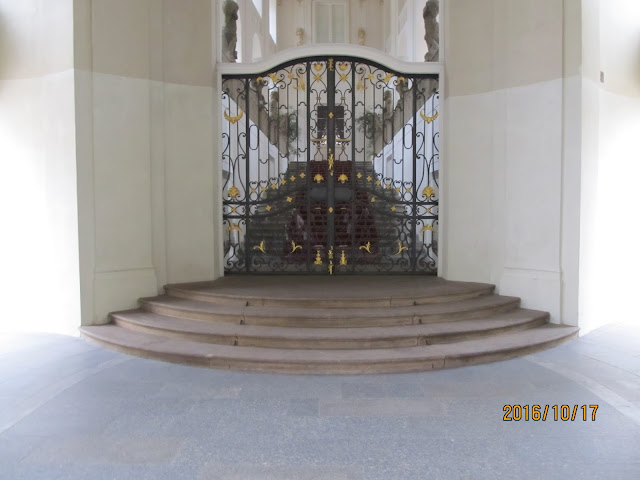













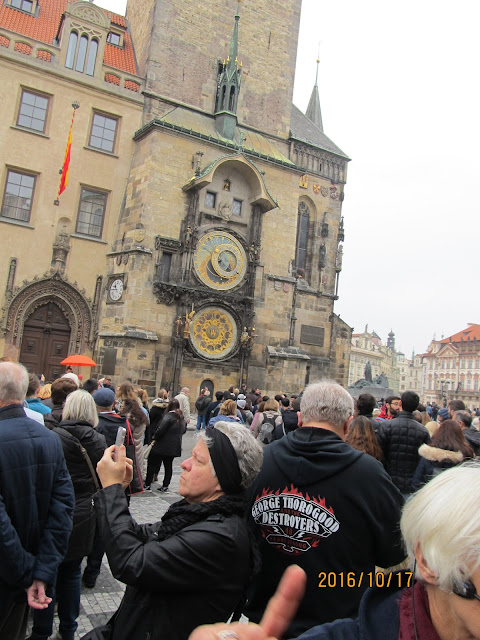







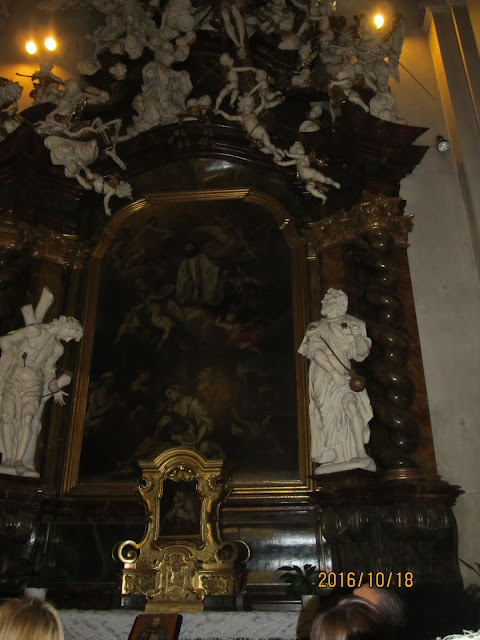













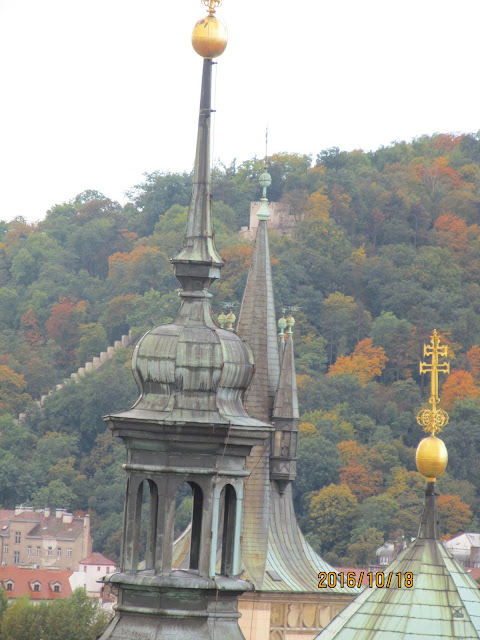














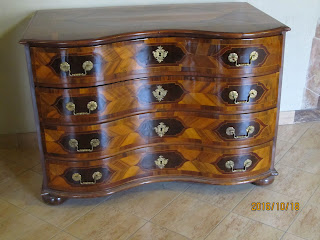






































No comments:
Post a Comment